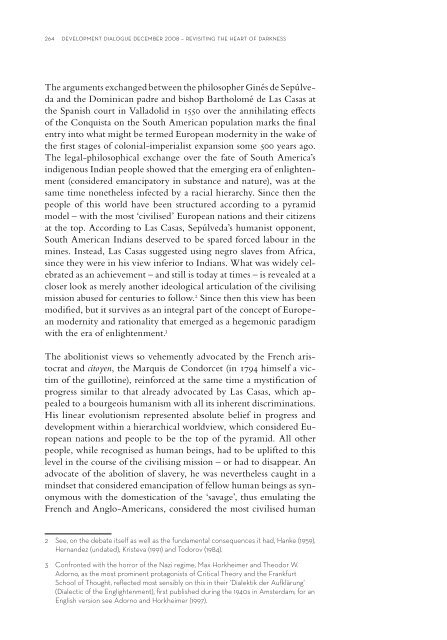60 years after the UN Convention - Dag Hammarskjöld Foundation
60 years after the UN Convention - Dag Hammarskjöld Foundation
60 years after the UN Convention - Dag Hammarskjöld Foundation
You also want an ePaper? Increase the reach of your titles
YUMPU automatically turns print PDFs into web optimized ePapers that Google loves.
264 development dialogue december 2008 – revisiting <strong>the</strong> heart of darkness<br />
The arguments exchanged between <strong>the</strong> philosopher Ginés de Sepúlveda<br />
and <strong>the</strong> Dominican padre and bishop Bartholomé de Las Casas at<br />
<strong>the</strong> Spanish court in Valladolid in 1550 over <strong>the</strong> annihilating eff ects<br />
of <strong>the</strong> Conquista on <strong>the</strong> South American population marks <strong>the</strong> fi nal<br />
entry into what might be termed European modernity in <strong>the</strong> wake of<br />
<strong>the</strong> fi rst stages of colonial-imperialist expansion some 500 <strong>years</strong> ago.<br />
The legal-philosophical exchange over <strong>the</strong> fate of South America’s<br />
indigenous Indian people showed that <strong>the</strong> emerging era of enlightenment<br />
(considered emancipatory in substance and nature), was at <strong>the</strong><br />
same time none<strong>the</strong>less infected by a racial hierarchy. Since <strong>the</strong>n <strong>the</strong><br />
people of this world have been structured according to a pyramid<br />
model – with <strong>the</strong> most ‘civilised’ European nations and <strong>the</strong>ir citizens<br />
at <strong>the</strong> top. According to Las Casas, Sepúlveda’s humanist opponent,<br />
South American Indians deserved to be spared forced labour in <strong>the</strong><br />
mines. Instead, Las Casas suggested using negro slaves from Africa,<br />
since <strong>the</strong>y were in his view inferior to Indians. What was widely celebrated<br />
as an achievement – and still is today at times – is revealed at a<br />
closer look as merely ano<strong>the</strong>r ideological articulation of <strong>the</strong> civilising<br />
mission abused for centuries to follow. 2 Since <strong>the</strong>n this view has been<br />
modifi ed, but it survives as an integral part of <strong>the</strong> concept of European<br />
modernity and rationality that emerged as a hegemonic paradigm<br />
with <strong>the</strong> era of enlightenment. 3<br />
The abolitionist views so vehemently advocated by <strong>the</strong> French aristocrat<br />
and citoyen, <strong>the</strong> Marquis de Condorcet (in 1794 himself a victim<br />
of <strong>the</strong> guillotine), reinforced at <strong>the</strong> same time a mystifi cation of<br />
progress similar to that already advocated by Las Casas, which appealed<br />
to a bourgeois humanism with all its inherent discriminations.<br />
His linear evolutionism represented absolute belief in progress and<br />
development within a hierarchical worldview, which considered European<br />
nations and people to be <strong>the</strong> top of <strong>the</strong> pyramid. All o<strong>the</strong>r<br />
people, while recognised as human beings, had to be uplifted to this<br />
level in <strong>the</strong> course of <strong>the</strong> civilising mission – or had to disappear. An<br />
advocate of <strong>the</strong> abolition of slavery, he was never<strong>the</strong>less caught in a<br />
mindset that considered emancipation of fellow human beings as synonymous<br />
with <strong>the</strong> domestication of <strong>the</strong> ‘savage’, thus emulating <strong>the</strong><br />
French and Anglo-Americans, considered <strong>the</strong> most civilised human<br />
2 See, on <strong>the</strong> debate itself as well as <strong>the</strong> fundamental consequences it had, Hanke (1959),<br />
Hernandez (undated), Kristeva (1991) and Todorov (1984).<br />
3 Confronted with <strong>the</strong> horror of <strong>the</strong> Nazi regime, Max Horkheimer and Theodor W.<br />
Adorno, as <strong>the</strong> most prominent protagonists of Critical Theory and <strong>the</strong> Frankfurt<br />
School of Thought, refl ected most sensibly on this in <strong>the</strong>ir ‘Dialektik der Aufklärung’<br />
(Dialectic of <strong>the</strong> Englightenment), fi rst published during <strong>the</strong> 1940s in Amsterdam; for an<br />
English version see Adorno and Horkheimer (1997).

















